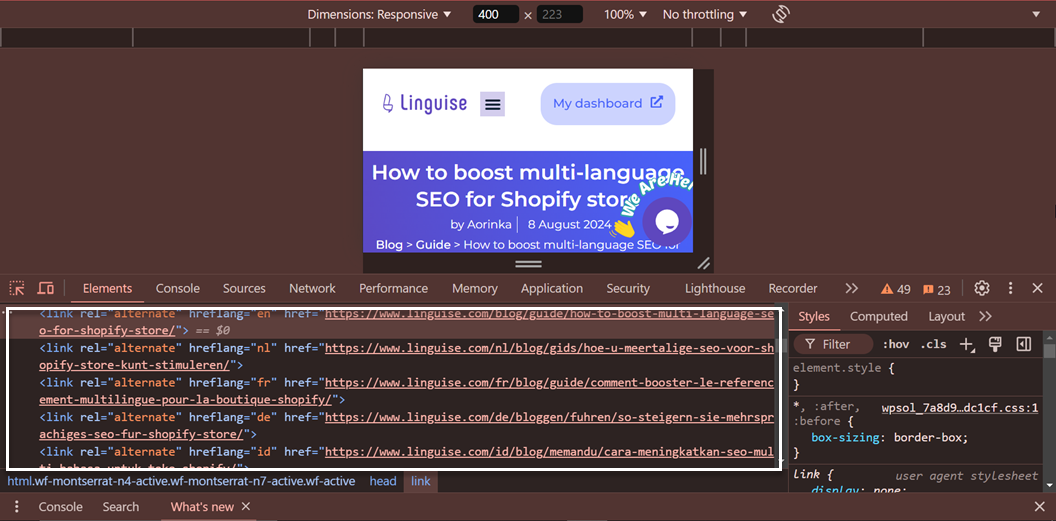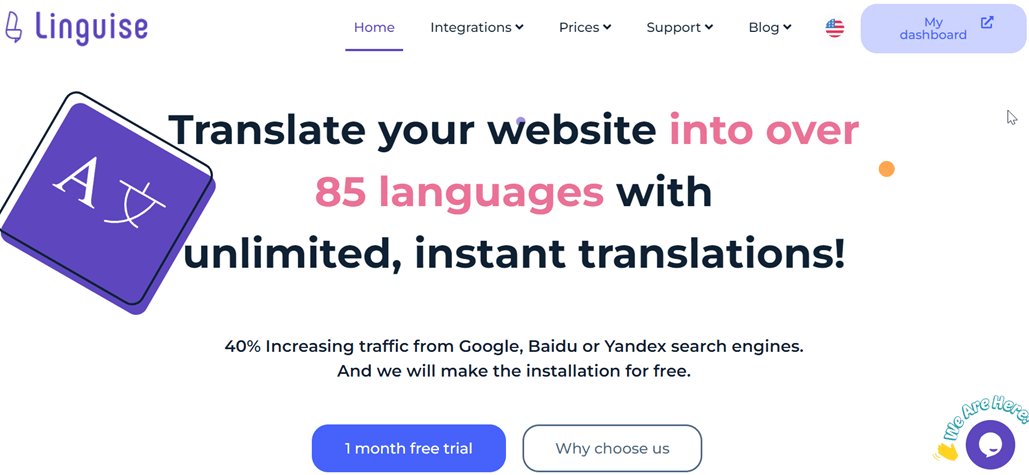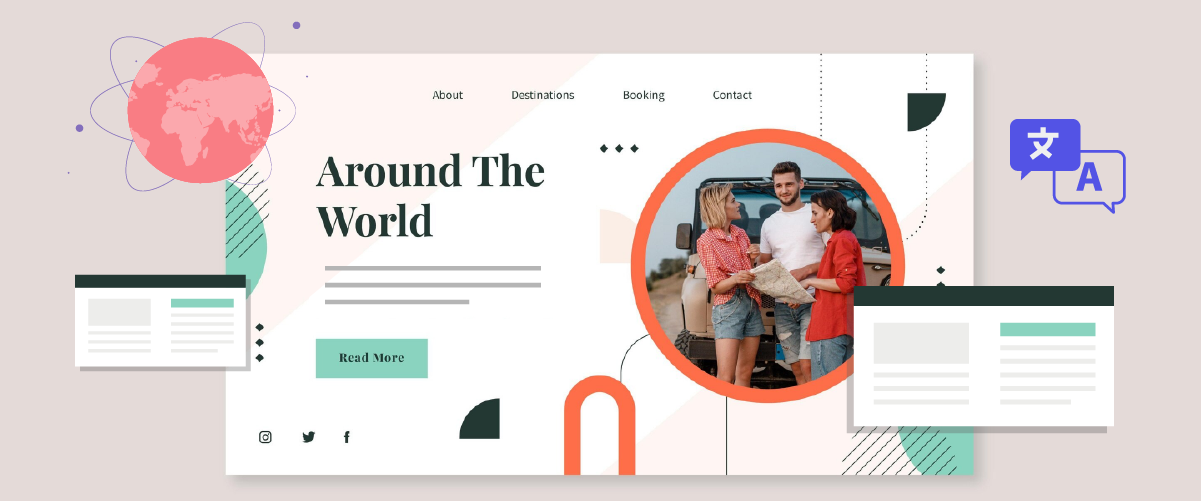International blogging has become a powerful way to share ideas and connect with a global audience. With over 600 million blogs worldwide and 5,45 billion internet users, the potential to reach readers across borders is huge.
You might wonder, “Can I really start an international blog?” The answer is yes! Whether you want to share your thoughts, build a global community, or earn money, international blogging offers endless opportunities.
In this guide, we’ll show you why starting an international blog is worth it and walk you through the key steps. From researching your audience to optimizing for international SEO, we’ve got everything you need to get started. Plus, we’ll highlight tools that make translating your content easier. Let’s discuss it!
Why should you start international blogging?

International blogging has become more than a trend—a powerful global communication and influence tool. Recent data shows that more than 5.45 billion people worldwide are active internet users, many of whom do not always speak English. This vast audience presents an incredible opportunity for bloggers willing to expand their horizons.
By reaching out to a global audience, you’re expanding your readership and opening doors to new possibilities. Imagine connecting with people from diverse cultures, sharing your insights across continents, and building a global brand. The benefits are numerous.
- Exponential growth in readership
- Increased potential for monetization
- Enhanced global brand recognition
- Rich networking opportunities
- Improved search engine visibility across multiple languages
Moreover, international blogging allows you to tap into niche markets that might be oversaturated in your home country but ripe for exploration elsewhere. It’s about translating website content, creating a bridge between cultures, fostering understanding, and becoming a thought leader on a global scale.
Step by step to start an international blog
Starting an international blog requires careful planning and execution. Here are steps to help you launch your global blogging journey successfully.
#1 Research your target market
Before you create content, it’s crucial to understand who you’re writing for. Think of this step as laying the foundation for your international blogging success. If you have an existing blog, start by analyzing your current audience, but remember that preferences can vary significantly across countries.
Consider using tools like Google Trends, SEMrush, or Ahrefs to clearly understand your target market. These platforms can provide valuable insights into popular topics in different regions. For example, you might discover that while health and wellness content is universally appealing, the specific focus areas can differ – perhaps yoga is more popular in one country, while high-intensity workouts trend in another.

Remember to look into cultural nuances, local holidays, and regional preferences. This research will help you create content that truly resonates with your international audience. Remember, the goal is to become a valuable resource for your readers, no matter where they’re from.
#2 Make a plan for your content
Now that you understand your target market well, it’s time to make a content plan. Consider this your roadmap to consistent, engaging content that speaks directly to your international audience.
Start by identifying core themes based on your research. These could be a mix of evergreen topics that always stay relevant and trending subjects that capture current interests. For instance, if you’re running a food blog, you might have evergreen content about basic cooking techniques while planning seasonal recipes or posts about emerging food trends in different countries.
Creating a content calendar is key. This helps you stay organized and ensures you’re covering a diverse range of topics. Include important dates or events relevant to your target regions – like national holidays or cultural festivals. This shows your audience that you understand and respect their culture.

Be sure to expand your blog beyond written content. Consider incorporating videos, podcasts, or infographics to make your blog more engaging and accessible to a diverse audience. For example, a cooking video might be more appealing than a written recipe for some of your readers.
Remember, your content plan should be flexible. Monitor trends and continue market research even after you’ve launched. This will help you stay relevant and responsive to your audience’s evolving interests.
#3 Localize your content
Localization is the key to making your international blog resonate with diverse audiences. It’s not just about translation; it’s about adapting your content to feel authentic and relevant in each target region. Here are the essential points to consider.
- Content localization: Adapt your content to local cultural norms, avoiding idioms or references that might not make sense in other cultures. For example, American football analogies can be replaced with soccer references for a global audience.
- Format adaptation: Adjust dates, times, measurements, and currencies to match local standards. This attention to detail respects your readers and prevents confusion. Consider using metric measurements for recipes to appeal to a broader international audience.
- Visual considerations: Consider the cultural significance of colors, symbols, and images in your content. For instance, while white is often associated with purity in Western cultures, it can symbolize mourning in some Asian countries. Localizing your design ensures that your visual elements are aesthetically pleasing, culturally appropriate, and meaningful across different regions.
- Legal and ethical compliance: Research local laws and cultural sensitivities. Acceptable content in one country may be problematic or even illegal in another. For example, discussing certain political topics or displaying particular religious symbols might be sensitive in specific regions. Stay informed to avoid unintentional offence or legal issues.
Remember, localization is an ongoing process. As you engage with your international audience, you’ll gain insights that help you continually improve your content’s relevance and impact across different cultures.
#4 Choose the right tools for translation
Choosing the right translation service is crucial to the success of your international blog. Many advanced translation tools and services are available to help you reach a global audience. Options like Linguise, TranslatePress, and Weglot simplify translating your content into multiple languages. But, when you choose these tools, make sure there are several things.
- Professional translators: For high-quality and culturally sensitive translations, consider hiring professional translators who are native speakers of your target languages. They ensure your content maintains its original tone, intent, and cultural relevance.
- Support for CMS and web builders: Ensure your tools are compatible with various CMS platforms and web builders, including WordPress, Shopify, etc. This flexibility will make integration and management easier.
- Machine translation with human editing: Consider using machine translation tools as a starting point, but always have a native speaker review and edit the output. This approach helps catch errors and improve fluency, ensuring the content reads naturally.
- Support for multilingual SEO: To optimize your blog for global reach, ensure that your translation tools and platforms support multilingual SEO. This includes properly translating meta tags, URLs, and keywords essential for ranking in different languages and regions.
Remember, the goal is to create content that reads naturally and resonates with each audience. Investing in quality translation tools and services is an investment in your blog’s global success.
#5 Optimize international SEO
International SEO is a game-changer in reaching your global audience effectively. It’s not just about translating keywords; it’s about understanding how people in different regions search for information. Let’s dive into some key strategies to boost your international SEO.

- Regional keyword research: Use tools like Google Keyword Planner or Ahrefs to identify popular search terms in your target languages. Remember, a direct translation of your English keywords might be different from what locals use in their searches.
- Localize meta tags and descriptions: Incorporate your researched keywords into your page titles, meta descriptions, and image alt tags. This helps search engines understand the relevance of your content for local searches.
- Implement hreflang tags: These special HTML tags tell search engines which language you use on a specific page. This prevents duplicate content issues and ensures the right version of your page appears in local search results.
- Submit multilingual sitemaps: Develop separate sitemaps for each language version of your site. This helps search engines index your content more efficiently and understand the structure of your multilingual site.
- Build local backlinks: Find opportunities to get backlinks from reputable websites in your target regions. This signals search engines that your content is valuable and relevant to that specific audience.
- Optimize for local search intent: Understand your international audience’s unique needs and search behaviors. For example, “football” might mean something different to searchers in the US versus the UK.
By focusing on these international SEO strategies, you’ll increase your chances of appearing in local search results and attracting the right audience to your blog, no matter where they’re located.
#6 Promote your content
Promoting your multilingual content is essential to building a loyal international readership. Here are some effective strategies for getting your blog in front of your target audience.

- Leverage multilingual social media: Create separate social media accounts for each language you target. This allows you to tailor your content and engage with followers in their native language. For instance, you might use Instagram for your English-speaking audience while focusing on WeChat for Chinese readers.
- Localize your social media strategy: Don’t just translate your posts – adapt them to local trends and interests. Use region-specific hashtags and post when your target audience is most active. For example, if you’re targeting Japan, you might create content around local holidays like Golden Week.
- Collaborate with local influencers: Partner with influencers with a strong following in your target regions. This can introduce your blog to a wider audience and lend credibility to your content. For instance, a food blogger expanding into Italy might collaborate with a popular Italian chef for a guest post or social media takeover.
- Run localized ad campaigns: If you’re using paid advertising, create campaigns that target specific regions and languages. Customize your ad copy and visuals to resonate with each local audience. For example, an ad targeting France during the summer might feature imagery of the French Riviera.
- Implement email marketing: Develop a segmented email list based on language preferences. Send personalized, translated content to each group. You could create language-specific newsletters featuring local events or trends relevant to each audience.
Remember, successful promotion is about creating genuine connections with your international audience. Be patient consistent, and always strive to provide value in every interaction.
Start international blogging with the Linguise translation service

Ready to take your blog go international? Let’s explore how Linguise automatic translation web can be your ultimate companion in this exciting journey. This powerful translation service is designed to make your international blogging dreams a reality, with features catering to novice bloggers and seasoned content creators alike.
1 - Instant installation
Imagine transforming your blog into a multilingual powerhouse in just a few clicks. That’s exactly what Linguise offers! You don’t need to be a tech wizard to get started. Simply grab your unique API key from Linguise, paste it into your blogging platform, and voilà! Your content is ready to speak multiple languages.
The best part? A sleek language switcher automatically appears on your site, allowing readers to toggle between languages effortlessly.
2 - Unlimited add your target languages
With Linguise, the world truly is your oyster. Want to reach readers in Spain, Japan, and Brazil? No problem! Linguise lets you add as many target languages as your heart desires. This flexibility is a game-changer for your international blog strategy.

Start small, with one or two additional languages, and gradually expand your linguistic reach as your audience grows. Whether targeting specific regions or aiming for global domination, Linguise adapts to your ambitions, helping you create a truly multicultural blogging experience.
3 - Correction and collaborate with professional translators
Let’s face it, even the best translation tools sometimes fail to catch up. But with Linguise, you’re always in control. Notice a translation that doesn’t capture your voice?
Simply hop into the front-end live editor and make your tweaks on the spot. It’s like having an eraser for those little linguistic hiccups. But here’s where it gets really exciting, Linguise allows you to invite professional translators to join your dashboard. Imagine collaborating with language experts who can fine-tune your content, ensuring it resonates perfectly with each target audience.
4 - Customize your language switcher
With Linguise, you’re not just getting a language switcher – you’re getting a customizable language switcher tool that seamlessly integrates with your blog’s design. Imagine being able to tweak every aspect of your language switcher to match your brand perfectly.
You can adjust the icons, play with the positioning, and even change the colors to create a cohesive look. This level of customization isn’t just about aesthetics; it’s about enhancing user experience. A well-designed, easily recognizable language switcher makes it effortless for your international readers to navigate your blog in their preferred language. It’s like giving them a friendly guide, always ready to assist in making your content accessible. This attention to detail can significantly boost engagement and keep visitors coming back for more.
5 - Exclude parts you don't want to translate
Sometimes, some aspects of your blog are best left in their original form. Think about brand names, technical terms, or even creative phrases that lose their charm in translation. Linguise gets this, which is why it allows you to exclude pages or specific parts from translation.

You can keep certain words, links, or entire pages in their original language across all translations or just for specific languages. This feature is powerful for maintaining brand consistency and preserving the integrity of specialized content. It’s like having a smart filter that knows which parts of your blog should remain untouched, ensuring that your message comes across clearly, regardless of the language.
6 - Fully support international SEO
Linguise doesn’t just translate your content; it supports your international SEO efforts. When you install Linguise, it automatically translates your URLs, making your content more discoverable in different languages. But that’s not all – Linguise also implements hreflang tags, like secret handshakes between your website and search engines. These tags tell search engines which language you use on a specific page, ensuring that the right content appears in the search results.

But Linguise takes it a step further. It automatically generates sitemaps for all your translated content; you only need to submit them to the search console. This simple step can significantly boost your visibility in international search results. It’s like giving search engines a roadmap to all your multilingual content, making it easier for them to index and rank your pages. The result? Better visibility, increased web traffic, and a stronger international presence for your blog.
7 - Other Linguise features
Linguise has additional features designed to make your international blogging experience smooth and effective.
- Dynamic content translation: Linguise doesn’t just handle static text. It can translate dynamic content on the fly, ensuring that even your most up-to-date information is accessible to all your readers, regardless of their language.
- Media and external link management: Have you ever wondered how to handle images or links in different languages? Linguise has got you covered. You can translate URLs for media and external links, ensuring a consistent experience across all language versions of your blog. It’s like creating a custom-tailored journey for each of your international readers, guiding them through your content in their native language.
These features work together to create a truly comprehensive solution for your international blog, helping you create a seamless, engaging experience for readers around the globe.
Conclusion

International blogging opens up opportunities for content creators looking to expand their reach and connect with a global audience. By following the steps – from researching your target market to optimizing for international SEO – you can transform your blog into a powerful platform that resonates with readers across cultures and languages.
Are you ready to take your blog to the global? Consider using Linguise as your translation tool to make the process smoother and more efficient. With features like instant installation, unlimited language options, and support for international SEO, Linguise can help you break down language barriers and create a truly multilingual blog. Don’t let language limits hold back your blogging ambitions – start your international blogging journey today with a create Linguise account!






